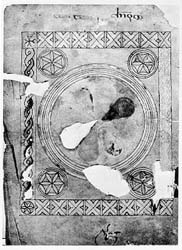 The Bobbio Orosius, from the 7th century, introduces an important motif to insular art, the Carpet Page. This is the oldest surviving carpet page. The design is not similar to the Carpet Pages in the later more famous gospel books (Durrow, Lindisfarne, Kells), but its purpose seem to have been similar; To serve as a sort of internal cover. As Dr. J. Kirsten Ataoguz points out over at Early Medieval Art, the Bobbio Orosius carpet page can be compared, at least in layout to the cover of the Stoneyhurst Gospels. (see below for image.) Like the later gospel books this carpet page faces a decorated initial. (I regret not having an image of the initial, and the poor image of the carpet page here, but it is all that is available on the net.)
The Bobbio Orosius, from the 7th century, introduces an important motif to insular art, the Carpet Page. This is the oldest surviving carpet page. The design is not similar to the Carpet Pages in the later more famous gospel books (Durrow, Lindisfarne, Kells), but its purpose seem to have been similar; To serve as a sort of internal cover. As Dr. J. Kirsten Ataoguz points out over at Early Medieval Art, the Bobbio Orosius carpet page can be compared, at least in layout to the cover of the Stoneyhurst Gospels. (see below for image.) Like the later gospel books this carpet page faces a decorated initial. (I regret not having an image of the initial, and the poor image of the carpet page here, but it is all that is available on the net.)The Bobbio Orosius also represents an important movement in the religious and artistic history of Europe. Although the manuscript was produced at a monastery in Italy, it was produced by Irish monks. The monastery in question, Bobbio was founded by St. Columbanus, who was from Ireland. Many important communities on the continent were founded by Irish monks. Many of the important "insular" manuscripts were in fact produced in the scriptoria of these communities. These monasteries were to play a vital role in the religious and artistic life of the next several centuries.
The manuscript itself (Milan, Biblioteca Ambrosiana MS D. 23. Sup.) is a copy of the Chronicon of Orosius. In the seventeenth century it was given to the newly established Ambrosian Library in Milan, where it remains today. Dr. Ataoguz also has a discussion of this manuscript at Early Medieval Art.
The Stonyhurst Gospel Covers

No comments:
Post a Comment